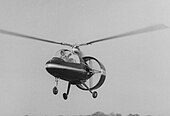ARC Aerosystems
| Role | Autogyro |
|---|---|
| National origin | UK |
| Number built | 6? |
ARC Aerosystems[1] is a British consortium that intends to produce modern CAA-certified VTOL autogyros[2] for commercial use. They have a prototype under test, the Pegasus VTOL-Tech,[3] which is to go into production, with delivery expected in 2026. ARC have plans for two other larger gyroplanes, the Linx P3 3-seater, and the Linx P9, a large winged gyroplane.
Production plans

In 2023, ARC Aerosystems acquired the intellectual property, all rights and type certification of the Avian Gyroplane (also called the "Pegasus"), including the last remaining flying example.[4] (The Avian Pegasus obtained full American FAA certification some decades ago).
ARC Aerosystems have since designed and produced the Pegasus VTOL Tec, a modern a two-seat, single-engine autogyro, closely modelled on the Avian Gyroplane, but with VTOL capacity. Prototypes have been built and on 13th November 2023, ARC Aerosystems announced the start of test flights of the Pegasus VTOL at its facilities in Cranfield (to gain CAA certification). Chris Taylor has been designated the ARC test pilot.[5] In 2024, ARC announced that they had an order for five Pegasus VTOL aircraft, to be delivered in 2026.[6][7]
ARC have published online plans for three aircraft designs using Pegasus technology. Of these three, only the Pegasus has had prototypes that are flying and approved for production:
- Pegasus VTOL Tech - a modern 2-seater gyroplane, a derivation of the Avian Gyroplane.
- Linx P3 - a 3-seater version of the Pegasus VTOL.
- Linx P9 - a large gyroplane with wings (or "composite aircraft") that is proposed to carry 2 pilots and 9 passengers.
How "Jump VTOL" is achieved with an autogyro
Normally, an autotogyro requires a runway, even though the take-off run is typically shorter than for a fixed-winged aeroplane. Unlike helicopters (whose main rotor is engine-powered), autotogyros do not have the ability to hover; but ARC claims that their autotogyros will have full VTOL capability, and may operate from heliports. ARC explains how VTOL is achieved, as follows:
- 1: Spin-up - Using auto-rotation, the large diameter rotor is spun up to a high speed (with the blades at zero incidence) using a high-torque electric motor.[8]
- 2: Take-off starts as the pilot pulls the collective pitchlever, increasing rotor blade pitch and simultaneously pushing engine throttles to full power. The rotor lifts the aircraft upward while the engines accelerate the aircraft forwards to achieve sustainable horizontal flight.[9] Once airborne, the electric drive to the rotor will disengage, and the aircraft will function as a standard autogyro. (It is not yet clear whether the electric drive could be re-engaged when landing).
ARC autogyro range
Pegasus VTOL Tech autogyro
Closely based on the Avian Autogyro, the Pegasus is a tandem-layout two-seat autogyro with a ducted-fan pusher propeller. It has a three-bladed rotor. The Pegasus is powered by a Lycoming 360 aero-engine, giving a 150kph cruise speed and a 160kph VNE. Given its seating capability, the Pegasus may be targeted as a trainer or for private general aviation.
Linx P3
Linx P3 (planned) - a 3-seater version of the Pegasus VTOL. A bigger and wider version of the Pegasus, the P3 is more suited to commercial work with a pilot and two passengers. (For instance, rather than use a much more expensive helicopter for medical air rescue, the P3 would be able to depart more quickly than a helicopter. It could carry two medical personnel to give first aid while awaiting the arrival of an ambulance).
Linx P9
Linx P9 (planned) - a fast 11-seater large twin-engined gyroplane, to be crewed by two pilots. The P9 will have retractable undercarriage and stubby fixed wings that will provide additional lift when in cruise. Intended for executive or commercial use, the P9's versatile payload space could accommodate:
- 9 passengers
- 6 passengers plus some cargo
- 2 passengers plus a bed for emergency patients and accident victims
- cargo only
ARC reckons the P9 will be 40% cheaper to run, with 30% more range, than equivalent size helicopters. They also claim that when used as executive air transport, there will be significant time savings[10] compared to equivalent helicopters or fixed-wing aircraft.[11]
See also
- AutoGyro Cavalon
- AutoGyro Calidus
- RotorSport UK Calidus
- Niki Lightning
- Niki Kallithea
- Sport Copter Lightning
References
- ^ ARC homepage [1]
- ^ Note: Autogyros are also known as "gyrocopters" and "gyroplanes".
- ^ Pegaus VTOL [2]
- ^ Perry, Dominic (May 2023). "The Linx effect". Flight International. 200 (5781): 42.
- ^ ARC announcement [3]
- ^ AAM report [4]
- ^ Note: ARC have reported that these purchasers are existing ARC investors. Because of their advanced "Jump VTOL" technology, ARC VTOL autogtros are expected to cost more than twice the price of equivalent standard autogyros, such as the AutoGyro Calidus or the AutoGyro Cavalon.
- ^ Note: whereas conventional autogyros use a "pre-rotator shaft" to spin the large rotor to only a modest RPM, the ARC's VTOL autogyros will use an electric motor initially to spin the main rotor at a much higher speed, sufficient for vertical take-off.
- ^ Note: This second stage in "Jump VTOL" will require considerable skill and co-ordination, and may need some "fly-by-wire" digital intervention.
- ^ Note: the time savings mainly arise from much quicker pre-flight preparations and checks.
- ^ ARC P9 specifications [5]
